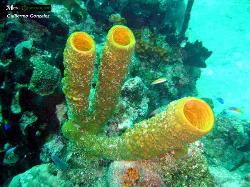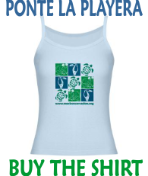

| Existen más de 9,000 especies de esponjas, que encontramos desde los trópicos hasta los círculos polares, a profundidades desde unos cuantos hasta miles de metros. La mayoría viven tan solo unos cuantos años, mientras otros pueden llegar a vivir cientos, incluso miles de años. También hay especies de agua dulce. Aunque la mayoría se alimentan de plancton, algunas especies carnívoras han desarrollado métodos para capturar presas mayores, como son camarones. Muchos tienen una forma hueca, como de tazón o vaso. Las paredes de este contenedor son altamente porosas. Estos poros forman canales donde bacterias, larvas y demás alimentos son filtrados del agua. Al igual que los corales, a las esponjas comúnmente se les confunde con plantas, pero son animales que en su etapa de larva nadan libremente. |
ESPONJAS
SPONGES
SPONGES
| There are over 9,000 different types of sponges, found from the tropics to the polar circles, in depths ranging from a few meters to thousands. Though most live only a few years, others can live for hundreds, and even thousands of years. There are even some freshwater species. Though most feed on plankton, a few carnivorous species have devised methods for capturing and feeding on larger animals, such as shrimp. They often share a hollowed-out shape, such as that of a bowl or tube. The walls of this container are highly porous. These pores lead to channels where bacteria, larvae and other foods are filtered from the water. Like corals, sponges are often confused for plants, but are in fact animals, and have a free-swimming larval stage early in life. |
| Photos by Guillermo Gonzalez and text by David Nuñez |
| Recomendamos estos libros sobre la Fauna de México. (Los nuestros son bilingues.) |
| To learn more about the Wildlife of Mexico, we recommend the following books. |















